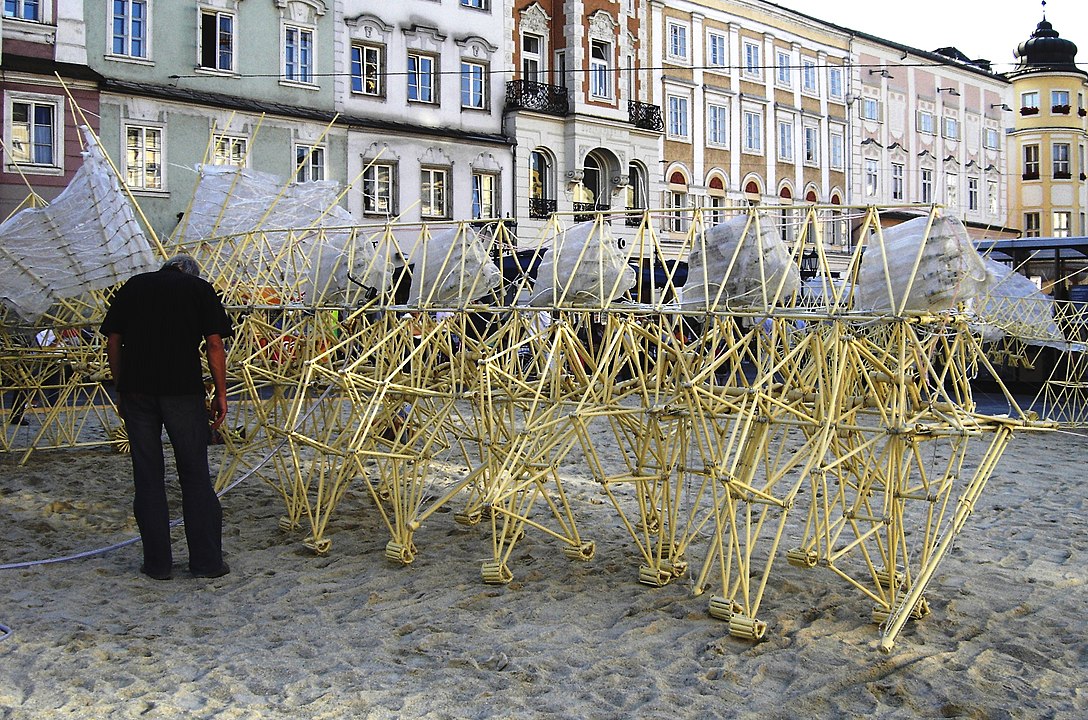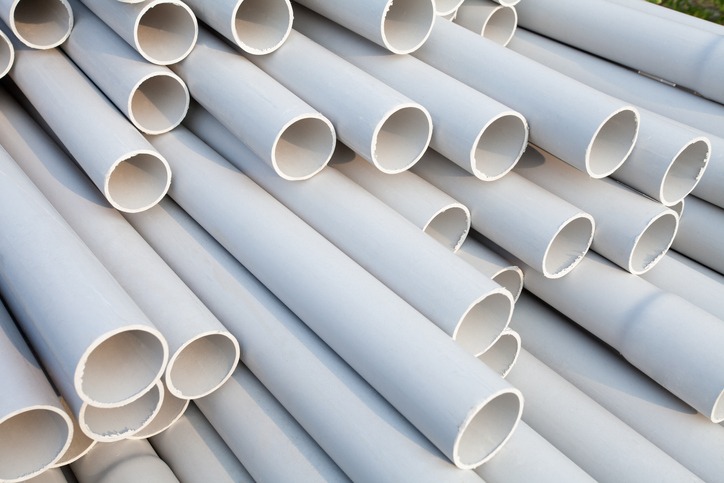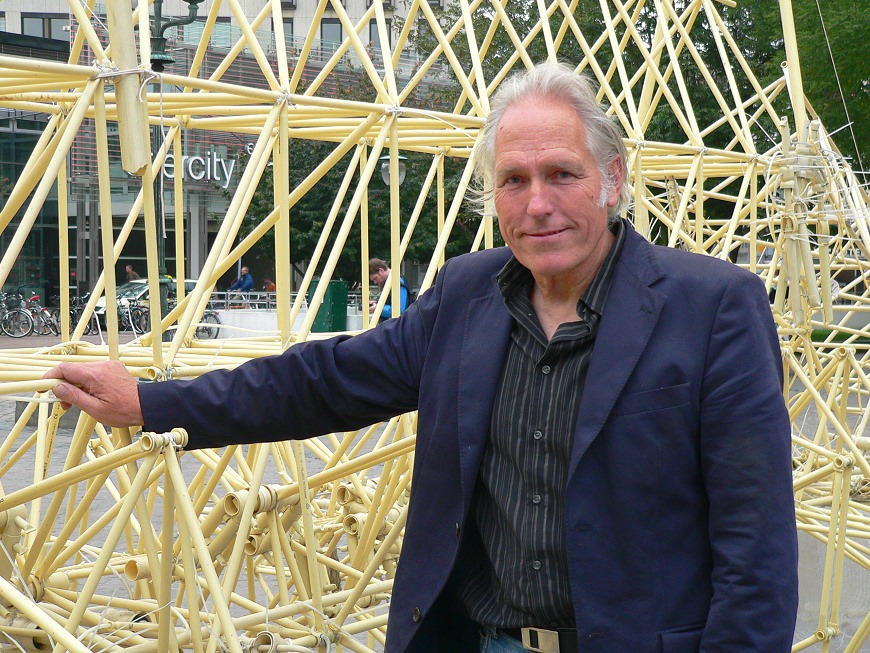In the fascinating intersection of art and engineering lies the Strandbeest, a series of kinetic sculptures that defy conventional boundaries. Created by Dutch artist Theo Jansen, these remarkable structures, often referred to as “beach beasts,” are more than just static art pieces; they are dynamic constructs that mimic the movements and complexities of living creatures.
Jansen, since 1990, has been crafting these large-scale works that elegantly walk the line between imaginative art and intricate mechanical design. This article delves into the world of the Strandbeest, exploring how Jansen’s innovative creations have captivated audiences worldwide with their lifelike motions and the ingenious use of simple materials.
What is the Strandbeest?
The Strandbeest, which translates to “beach animals” in Dutch, is a series of kinetic sculptures that represent a unique blend of artistry and engineering. These extraordinary creations are the brainchild of Dutch artist Theo Jansen, who embarked on this ongoing project in 1990. His vision was to create large-scale, autonomous structures that could move and exist independently on the sandy beaches of the Netherlands.
The Genesis of the Strandbeest
Theo Jansen, initially a painter, was inspired by the computational potential of simple materials like PVC pipes, which he saw as an “artificial muscle.” His first Strandbeest was a rudimentary structure, primarily a proof of concept. Over the years, Jansen refined his designs, creating more sophisticated models that could walk, propelled by wind power, across the beach.
Evolution of the Design
Jansen’s Strandbeest has evolved significantly since its inception. Early models were simpler, but as Jansen’s understanding of aerodynamics and kinetics deepened, so did the complexity of his creations. The Strandbeest are characterized by their spider-like legs, which are powered by wind catching in their wing-like sails. The mechanisms Jansen uses are based on his own theories of artificial life, specifically the concept of “survival of the fittest,” where each new Strandbeest incorporates improvements over previous models.
The Materials and Mechanics
Strandbeest is predominantly made from PVC piping, a lightweight yet sturdy material. Jansen meticulously assembles these pipes, along with other materials like fabric sails and tie wraps, to create the skeletons of these creatures. The mechanics of the Strandbeest are based on Jansen’s algorithm that simulates natural walking motion, allowing the structures to move in a lifelike and energy-efficient manner.
The Artistic and Philosophical Aspects of the Strandbeest
Beyond their mechanical ingenuity, the Strandbeest is a profound artistic exploration. They embody Jansen’s philosophical musings on the boundaries between the animate and inanimate, challenging our perceptions of life and mechanics. Each Strandbeest is not just a kinetic sculpture but a statement on the potential harmony between nature and machine.
Who is Theo Jansen?
Theo Jansen, a Dutch artist and kinetic sculptor, has carved a unique niche in the art world with his extraordinary creations, the Strandbeest. Born in The Hague, Netherlands, in 1948, Jansen’s journey as an artist is as unconventional as it is inspiring, blending elements of science, art, and engineering in his work.
From Physics to Artistic Creation
Originally studying physics at the University of Delft, Jansen’s fascination with the complexities of the natural world eventually drew him towards art. His scientific background, however, profoundly influenced his artistic endeavors, leading him to explore the realms of kinetic sculpture.
The Birth of the Strandbeest
Jansen’s most notable work, the Strandbeest, began as an experimental project in 1990. His aim was to create large-scale works that could interact with their environment in a lifelike manner. Drawing on his knowledge of mechanics and the natural world, Jansen embarked on creating these wind-powered sculptures, which he envisioned as new forms of life.
Philosophy and Artistic Vision
Jansen’s work is deeply rooted in his philosophical views about the relationship between humans and the natural world. He sees his Strandbeest as an exploration of the boundaries between the animate and inanimate, challenging our conventional views on what constitutes life and motion. His sculptures are not just artistic expressions but also embody his contemplations on evolution, survival, and the environment.
Recognition and Impact
Over the years, Jansen’s Strandbeest has gained significant international recognition, captivating audiences with its graceful, otherworldly movements. His work has been featured in numerous exhibitions and documentaries, mesmerizing viewers with the blend of artistic beauty and mechanical complexity.
Continuing Evolution
Jansen continues to refine and evolve his Strandbeest, each iteration becoming more sophisticated. He envisions a future where these creations can survive on their own on the beaches, adapting to changing environments – a testament to his ongoing quest to blur the lines between art and life.
Theo Jansen stands out as an artist who pushes the boundaries of creativity and innovation. His Strandbeest project reflects a unique fusion of artistic vision, scientific understanding, and engineering prowess, marking him as a significant figure in contemporary art and a visionary in kinetic sculpture. His work not only entertains and inspires but also invites us to ponder the deeper connections between art, nature, and technology.
Conclusion
The Strandbeest project is a remarkable journey in both art and engineering. From the beaches of the Netherlands, these wind-propelled creatures have garnered international acclaim, captivating audiences with their elegant, lifelike movements and the imaginative vision of their creator. The Strandbeest is evidence of the endless possibilities that arise when art merges with the science of mechanics.


